University Marketing Assignment: Value Offering for Lidl Supermarket
VerifiedAdded on 2023/04/07
|10
|1734
|308
Homework Assignment
AI Summary
This assignment analyzes the marketing strategies of the supermarket chain Lidl, focusing on its value offering. It begins by examining Lidl's product and service offerings, highlighting its economy-pricing strategy and emphasis on in-house brands. The assignment categorizes Lidl's offerings as convenience products and discusses how this impacts its target market and potential for product line extensions. It then delves into Lidl's product lifecycle stage, marketing channels (primarily direct), and pricing strategy. The analysis covers direct store delivery, value chain, and the use of economy pricing, along with recommendations for bundle pricing. The assignment concludes by referencing key factors influencing consumer decisions in selecting a supermarket and suggesting strategies for extending the product line and expanding the target market. It also uses perceptual maps and references to support the analysis.
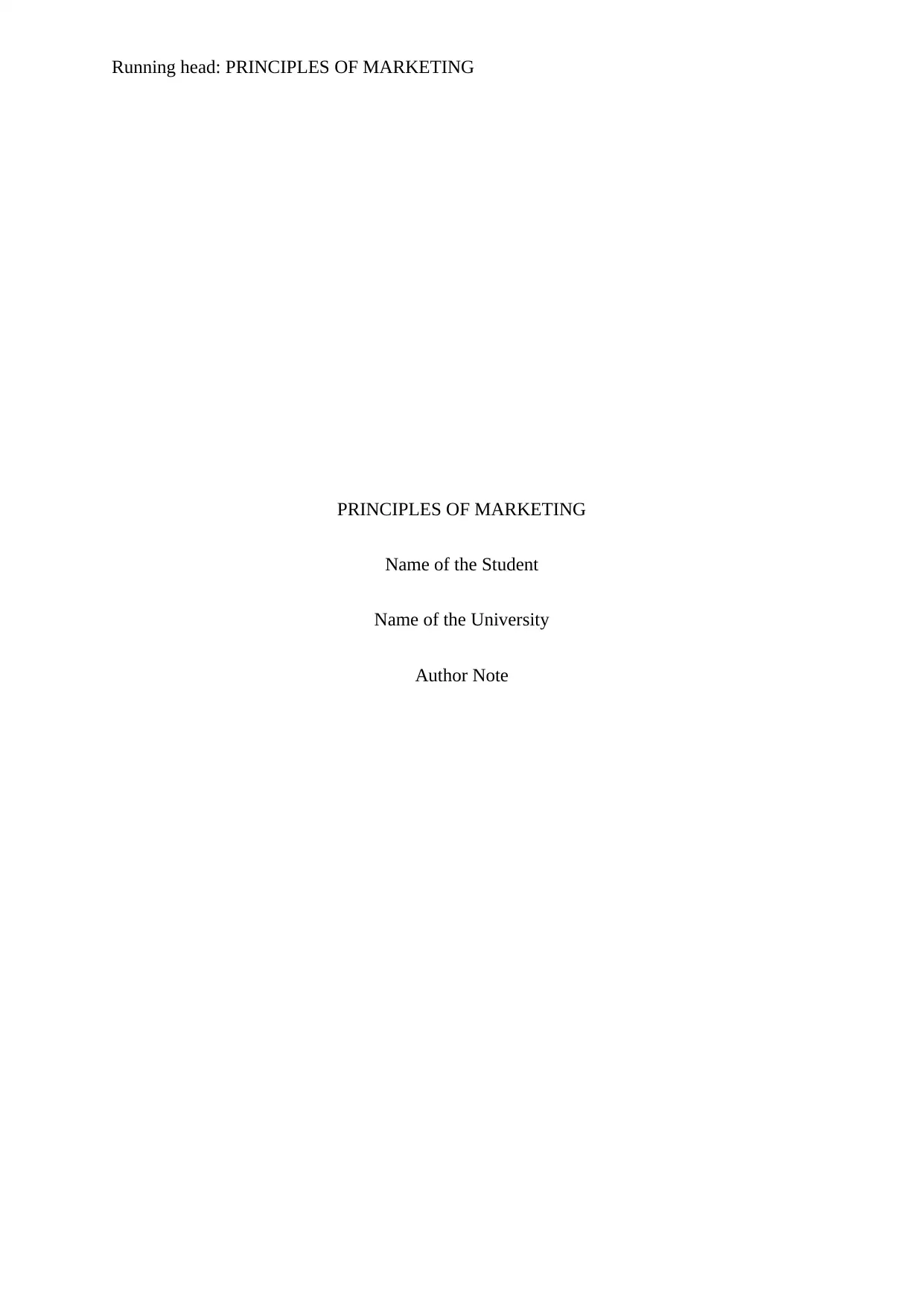
Running head: PRINCIPLES OF MARKETING
PRINCIPLES OF MARKETING
Name of the Student
Name of the University
Author Note
PRINCIPLES OF MARKETING
Name of the Student
Name of the University
Author Note
Paraphrase This Document
Need a fresh take? Get an instant paraphrase of this document with our AI Paraphraser
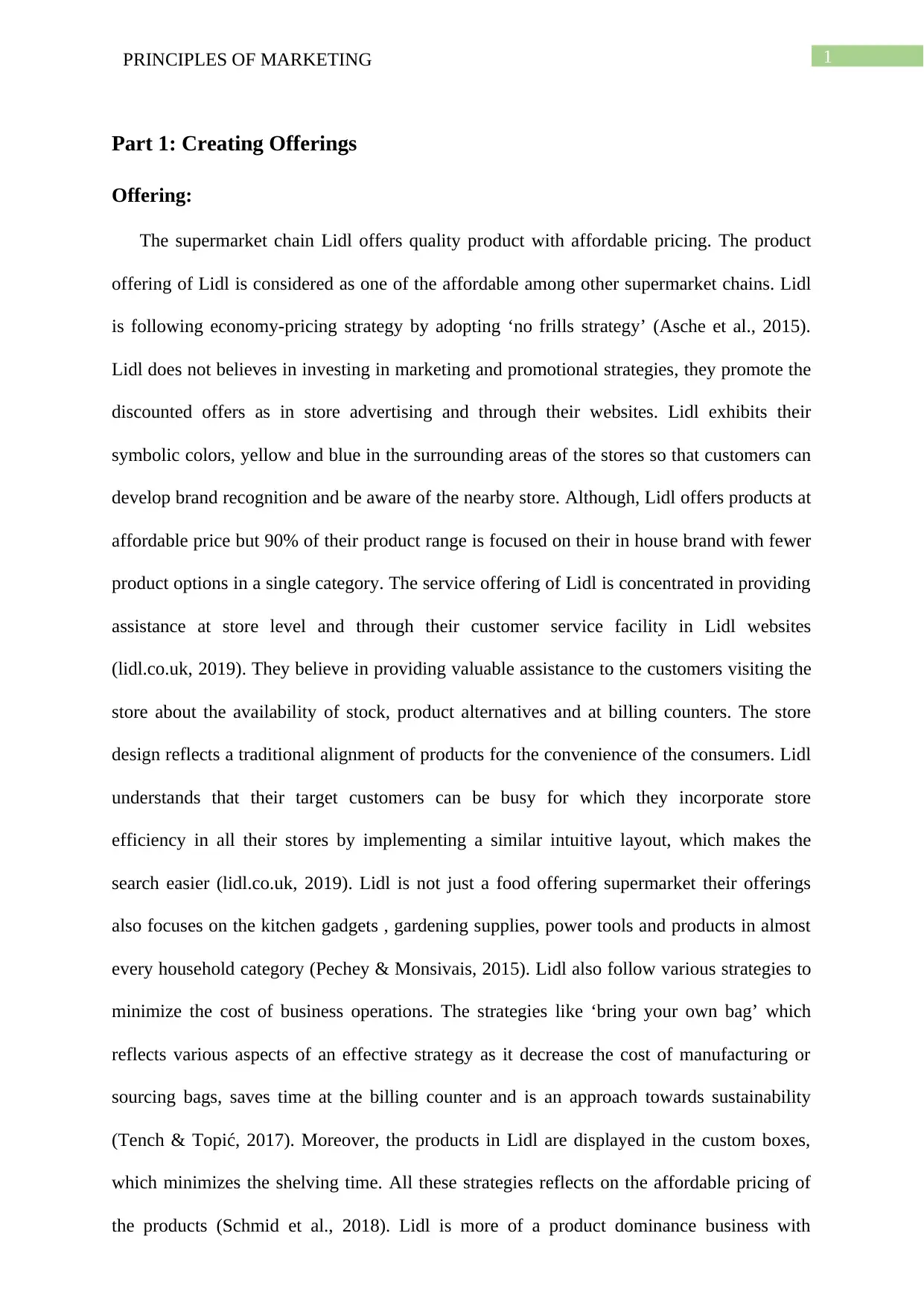
1PRINCIPLES OF MARKETING
Part 1: Creating Offerings
Offering:
The supermarket chain Lidl offers quality product with affordable pricing. The product
offering of Lidl is considered as one of the affordable among other supermarket chains. Lidl
is following economy-pricing strategy by adopting ‘no frills strategy’ (Asche et al., 2015).
Lidl does not believes in investing in marketing and promotional strategies, they promote the
discounted offers as in store advertising and through their websites. Lidl exhibits their
symbolic colors, yellow and blue in the surrounding areas of the stores so that customers can
develop brand recognition and be aware of the nearby store. Although, Lidl offers products at
affordable price but 90% of their product range is focused on their in house brand with fewer
product options in a single category. The service offering of Lidl is concentrated in providing
assistance at store level and through their customer service facility in Lidl websites
(lidl.co.uk, 2019). They believe in providing valuable assistance to the customers visiting the
store about the availability of stock, product alternatives and at billing counters. The store
design reflects a traditional alignment of products for the convenience of the consumers. Lidl
understands that their target customers can be busy for which they incorporate store
efficiency in all their stores by implementing a similar intuitive layout, which makes the
search easier (lidl.co.uk, 2019). Lidl is not just a food offering supermarket their offerings
also focuses on the kitchen gadgets , gardening supplies, power tools and products in almost
every household category (Pechey & Monsivais, 2015). Lidl also follow various strategies to
minimize the cost of business operations. The strategies like ‘bring your own bag’ which
reflects various aspects of an effective strategy as it decrease the cost of manufacturing or
sourcing bags, saves time at the billing counter and is an approach towards sustainability
(Tench & Topić, 2017). Moreover, the products in Lidl are displayed in the custom boxes,
which minimizes the shelving time. All these strategies reflects on the affordable pricing of
the products (Schmid et al., 2018). Lidl is more of a product dominance business with
Part 1: Creating Offerings
Offering:
The supermarket chain Lidl offers quality product with affordable pricing. The product
offering of Lidl is considered as one of the affordable among other supermarket chains. Lidl
is following economy-pricing strategy by adopting ‘no frills strategy’ (Asche et al., 2015).
Lidl does not believes in investing in marketing and promotional strategies, they promote the
discounted offers as in store advertising and through their websites. Lidl exhibits their
symbolic colors, yellow and blue in the surrounding areas of the stores so that customers can
develop brand recognition and be aware of the nearby store. Although, Lidl offers products at
affordable price but 90% of their product range is focused on their in house brand with fewer
product options in a single category. The service offering of Lidl is concentrated in providing
assistance at store level and through their customer service facility in Lidl websites
(lidl.co.uk, 2019). They believe in providing valuable assistance to the customers visiting the
store about the availability of stock, product alternatives and at billing counters. The store
design reflects a traditional alignment of products for the convenience of the consumers. Lidl
understands that their target customers can be busy for which they incorporate store
efficiency in all their stores by implementing a similar intuitive layout, which makes the
search easier (lidl.co.uk, 2019). Lidl is not just a food offering supermarket their offerings
also focuses on the kitchen gadgets , gardening supplies, power tools and products in almost
every household category (Pechey & Monsivais, 2015). Lidl also follow various strategies to
minimize the cost of business operations. The strategies like ‘bring your own bag’ which
reflects various aspects of an effective strategy as it decrease the cost of manufacturing or
sourcing bags, saves time at the billing counter and is an approach towards sustainability
(Tench & Topić, 2017). Moreover, the products in Lidl are displayed in the custom boxes,
which minimizes the shelving time. All these strategies reflects on the affordable pricing of
the products (Schmid et al., 2018). Lidl is more of a product dominance business with
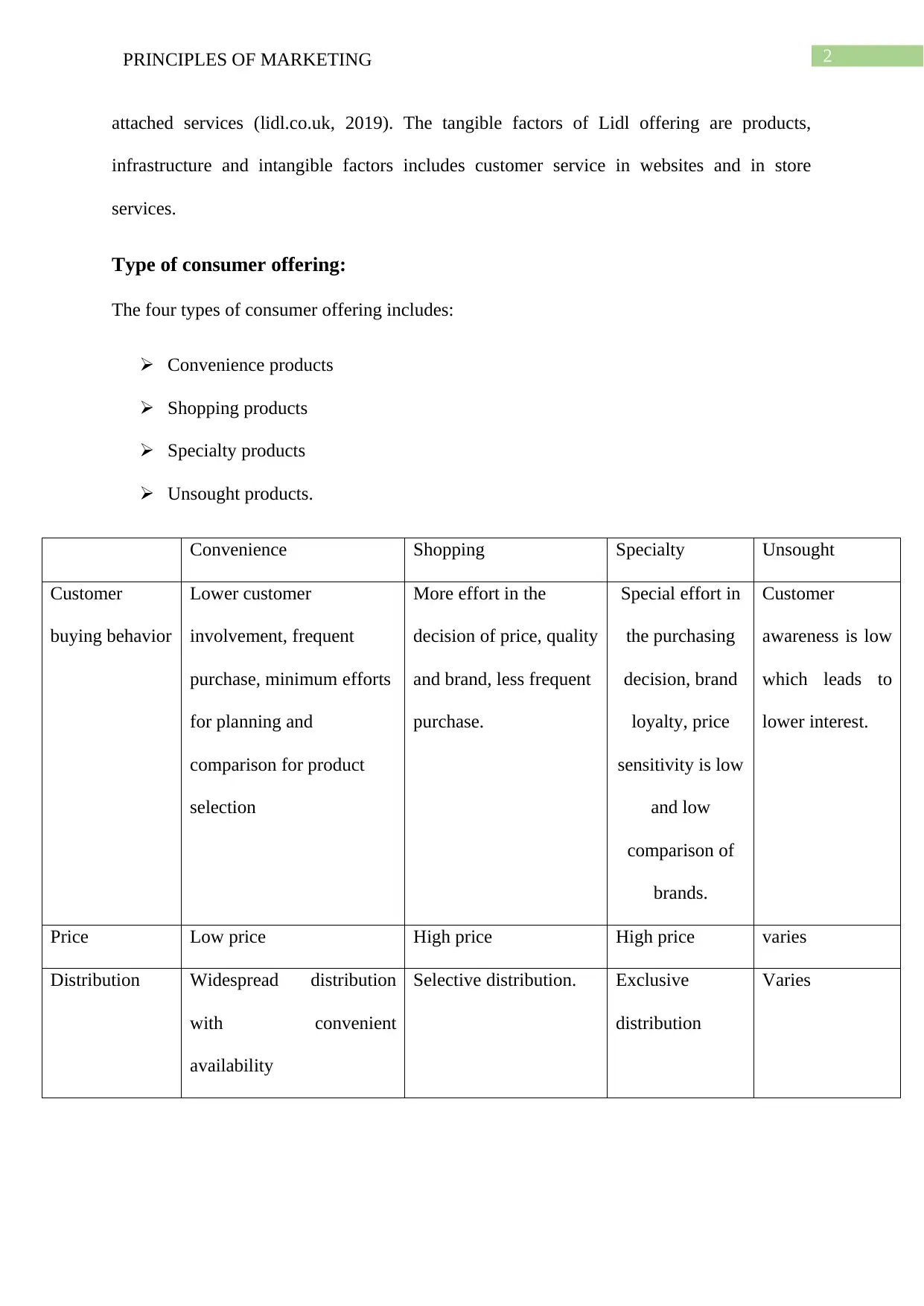
2PRINCIPLES OF MARKETING
attached services (lidl.co.uk, 2019). The tangible factors of Lidl offering are products,
infrastructure and intangible factors includes customer service in websites and in store
services.
Type of consumer offering:
The four types of consumer offering includes:
Convenience products
Shopping products
Specialty products
Unsought products.
Convenience Shopping Specialty Unsought
Customer
buying behavior
Lower customer
involvement, frequent
purchase, minimum efforts
for planning and
comparison for product
selection
More effort in the
decision of price, quality
and brand, less frequent
purchase.
Special effort in
the purchasing
decision, brand
loyalty, price
sensitivity is low
and low
comparison of
brands.
Customer
awareness is low
which leads to
lower interest.
Price Low price High price High price varies
Distribution Widespread distribution
with convenient
availability
Selective distribution. Exclusive
distribution
Varies
attached services (lidl.co.uk, 2019). The tangible factors of Lidl offering are products,
infrastructure and intangible factors includes customer service in websites and in store
services.
Type of consumer offering:
The four types of consumer offering includes:
Convenience products
Shopping products
Specialty products
Unsought products.
Convenience Shopping Specialty Unsought
Customer
buying behavior
Lower customer
involvement, frequent
purchase, minimum efforts
for planning and
comparison for product
selection
More effort in the
decision of price, quality
and brand, less frequent
purchase.
Special effort in
the purchasing
decision, brand
loyalty, price
sensitivity is low
and low
comparison of
brands.
Customer
awareness is low
which leads to
lower interest.
Price Low price High price High price varies
Distribution Widespread distribution
with convenient
availability
Selective distribution. Exclusive
distribution
Varies
⊘ This is a preview!⊘
Do you want full access?
Subscribe today to unlock all pages.

Trusted by 1+ million students worldwide
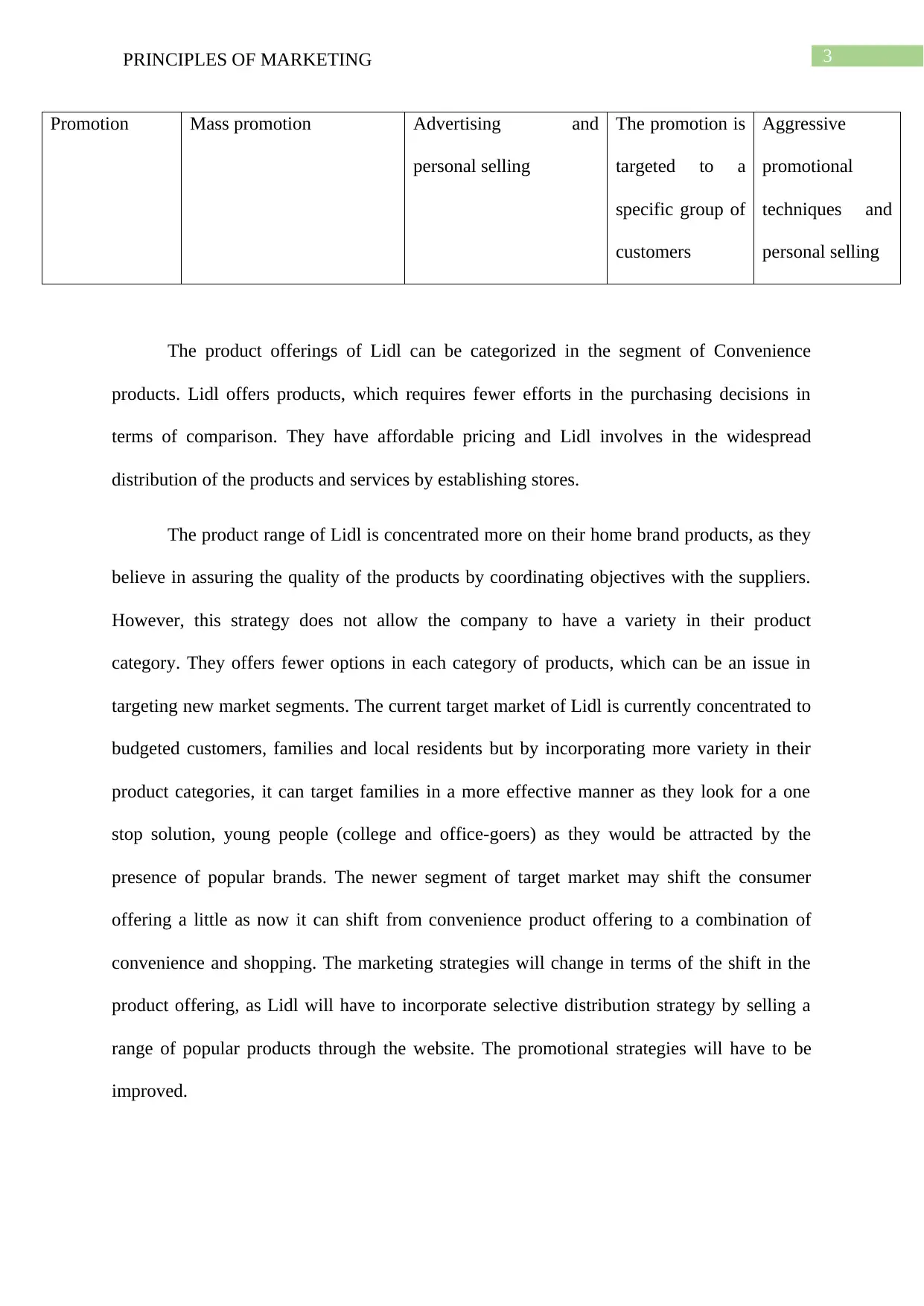
3PRINCIPLES OF MARKETING
Promotion Mass promotion Advertising and
personal selling
The promotion is
targeted to a
specific group of
customers
Aggressive
promotional
techniques and
personal selling
The product offerings of Lidl can be categorized in the segment of Convenience
products. Lidl offers products, which requires fewer efforts in the purchasing decisions in
terms of comparison. They have affordable pricing and Lidl involves in the widespread
distribution of the products and services by establishing stores.
The product range of Lidl is concentrated more on their home brand products, as they
believe in assuring the quality of the products by coordinating objectives with the suppliers.
However, this strategy does not allow the company to have a variety in their product
category. They offers fewer options in each category of products, which can be an issue in
targeting new market segments. The current target market of Lidl is currently concentrated to
budgeted customers, families and local residents but by incorporating more variety in their
product categories, it can target families in a more effective manner as they look for a one
stop solution, young people (college and office-goers) as they would be attracted by the
presence of popular brands. The newer segment of target market may shift the consumer
offering a little as now it can shift from convenience product offering to a combination of
convenience and shopping. The marketing strategies will change in terms of the shift in the
product offering, as Lidl will have to incorporate selective distribution strategy by selling a
range of popular products through the website. The promotional strategies will have to be
improved.
Promotion Mass promotion Advertising and
personal selling
The promotion is
targeted to a
specific group of
customers
Aggressive
promotional
techniques and
personal selling
The product offerings of Lidl can be categorized in the segment of Convenience
products. Lidl offers products, which requires fewer efforts in the purchasing decisions in
terms of comparison. They have affordable pricing and Lidl involves in the widespread
distribution of the products and services by establishing stores.
The product range of Lidl is concentrated more on their home brand products, as they
believe in assuring the quality of the products by coordinating objectives with the suppliers.
However, this strategy does not allow the company to have a variety in their product
category. They offers fewer options in each category of products, which can be an issue in
targeting new market segments. The current target market of Lidl is currently concentrated to
budgeted customers, families and local residents but by incorporating more variety in their
product categories, it can target families in a more effective manner as they look for a one
stop solution, young people (college and office-goers) as they would be attracted by the
presence of popular brands. The newer segment of target market may shift the consumer
offering a little as now it can shift from convenience product offering to a combination of
convenience and shopping. The marketing strategies will change in terms of the shift in the
product offering, as Lidl will have to incorporate selective distribution strategy by selling a
range of popular products through the website. The promotional strategies will have to be
improved.
Paraphrase This Document
Need a fresh take? Get an instant paraphrase of this document with our AI Paraphraser
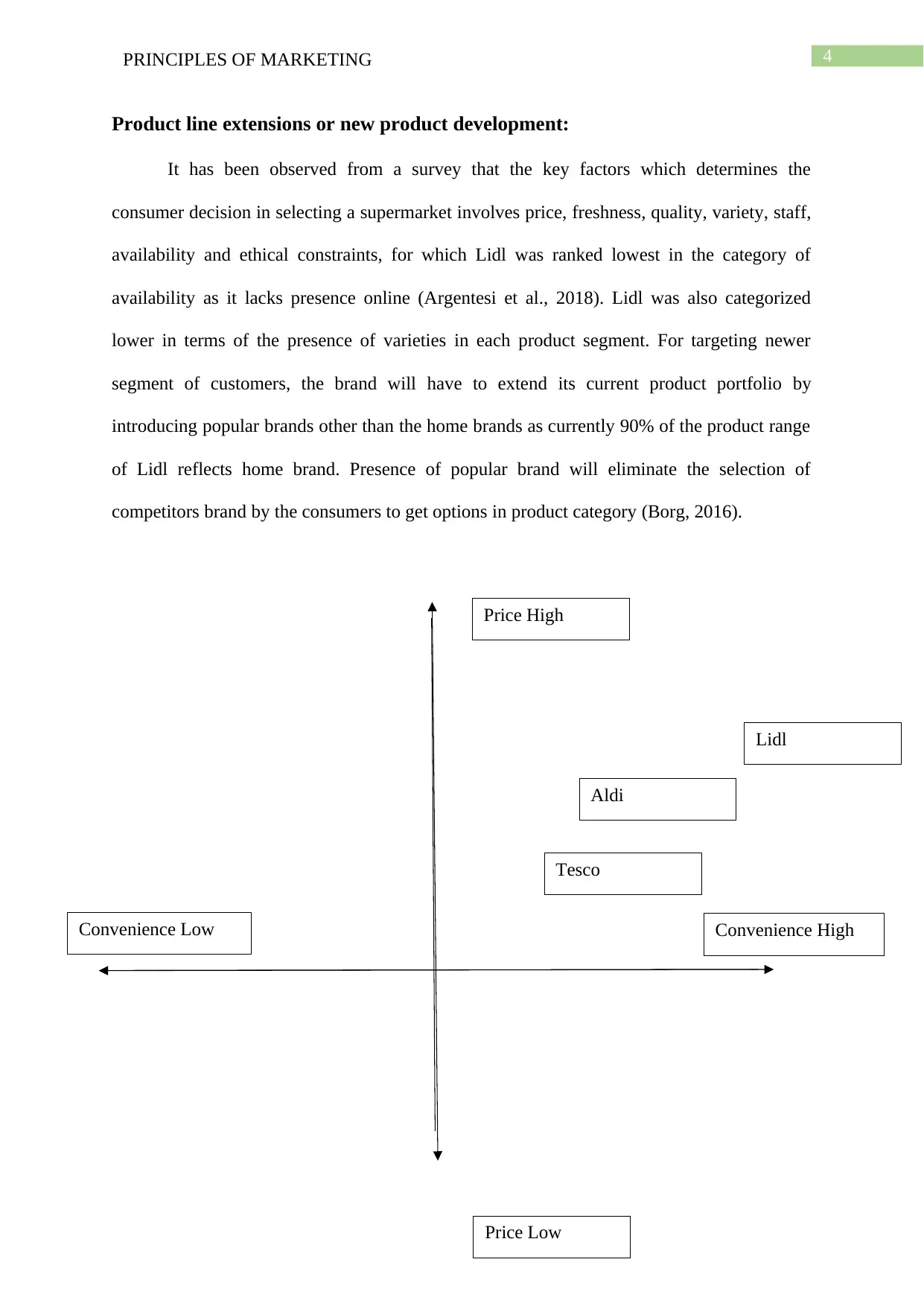
4PRINCIPLES OF MARKETING
Product line extensions or new product development:
It has been observed from a survey that the key factors which determines the
consumer decision in selecting a supermarket involves price, freshness, quality, variety, staff,
availability and ethical constraints, for which Lidl was ranked lowest in the category of
availability as it lacks presence online (Argentesi et al., 2018). Lidl was also categorized
lower in terms of the presence of varieties in each product segment. For targeting newer
segment of customers, the brand will have to extend its current product portfolio by
introducing popular brands other than the home brands as currently 90% of the product range
of Lidl reflects home brand. Presence of popular brand will eliminate the selection of
competitors brand by the consumers to get options in product category (Borg, 2016).
Price High
Convenience High
Price Low
Convenience Low
Lidl
Aldi
Tesco
Product line extensions or new product development:
It has been observed from a survey that the key factors which determines the
consumer decision in selecting a supermarket involves price, freshness, quality, variety, staff,
availability and ethical constraints, for which Lidl was ranked lowest in the category of
availability as it lacks presence online (Argentesi et al., 2018). Lidl was also categorized
lower in terms of the presence of varieties in each product segment. For targeting newer
segment of customers, the brand will have to extend its current product portfolio by
introducing popular brands other than the home brands as currently 90% of the product range
of Lidl reflects home brand. Presence of popular brand will eliminate the selection of
competitors brand by the consumers to get options in product category (Borg, 2016).
Price High
Convenience High
Price Low
Convenience Low
Lidl
Aldi
Tesco
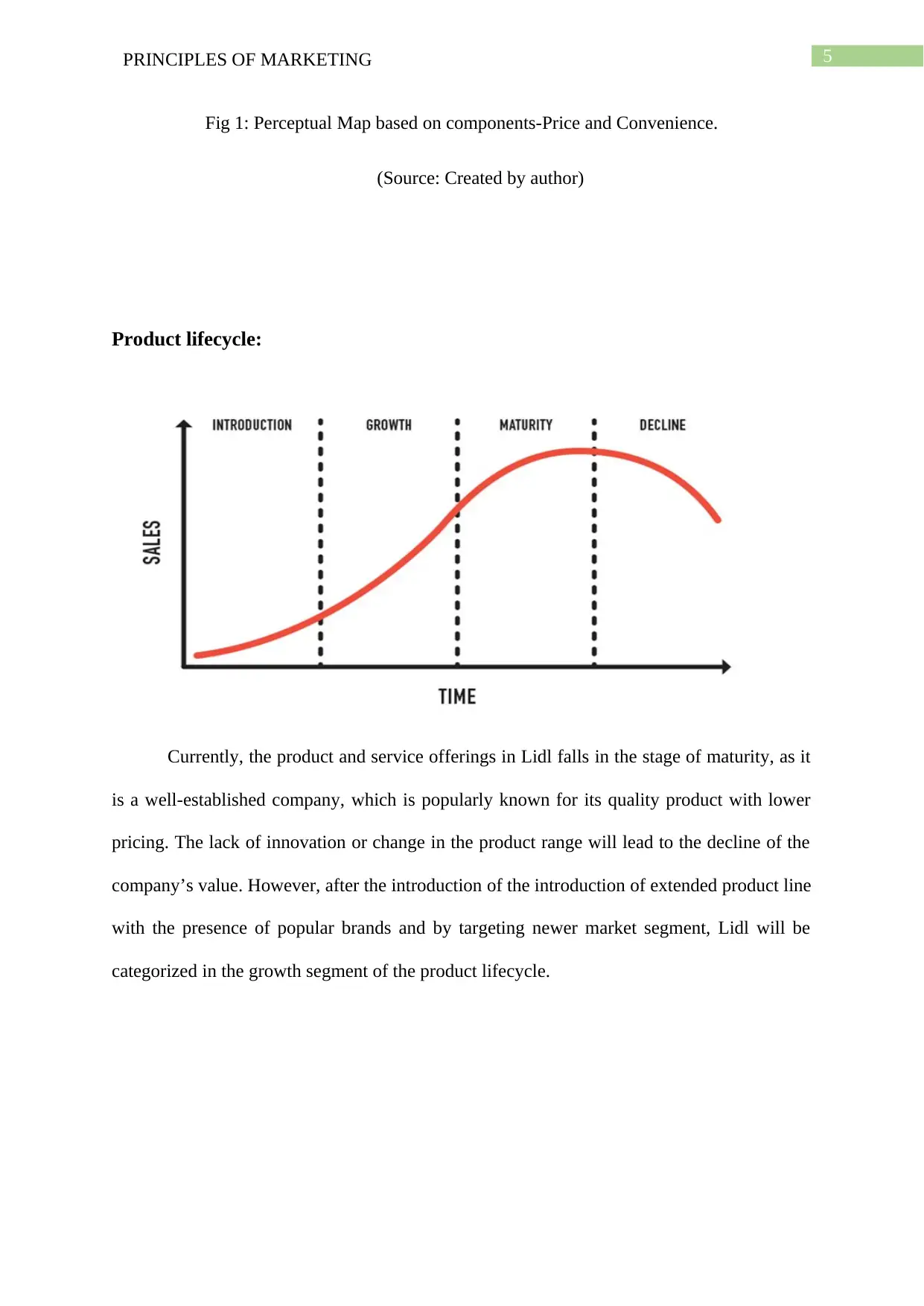
5PRINCIPLES OF MARKETING
Fig 1: Perceptual Map based on components-Price and Convenience.
(Source: Created by author)
Product lifecycle:
Currently, the product and service offerings in Lidl falls in the stage of maturity, as it
is a well-established company, which is popularly known for its quality product with lower
pricing. The lack of innovation or change in the product range will lead to the decline of the
company’s value. However, after the introduction of the introduction of extended product line
with the presence of popular brands and by targeting newer market segment, Lidl will be
categorized in the growth segment of the product lifecycle.
Fig 1: Perceptual Map based on components-Price and Convenience.
(Source: Created by author)
Product lifecycle:
Currently, the product and service offerings in Lidl falls in the stage of maturity, as it
is a well-established company, which is popularly known for its quality product with lower
pricing. The lack of innovation or change in the product range will lead to the decline of the
company’s value. However, after the introduction of the introduction of extended product line
with the presence of popular brands and by targeting newer market segment, Lidl will be
categorized in the growth segment of the product lifecycle.
⊘ This is a preview!⊘
Do you want full access?
Subscribe today to unlock all pages.

Trusted by 1+ million students worldwide
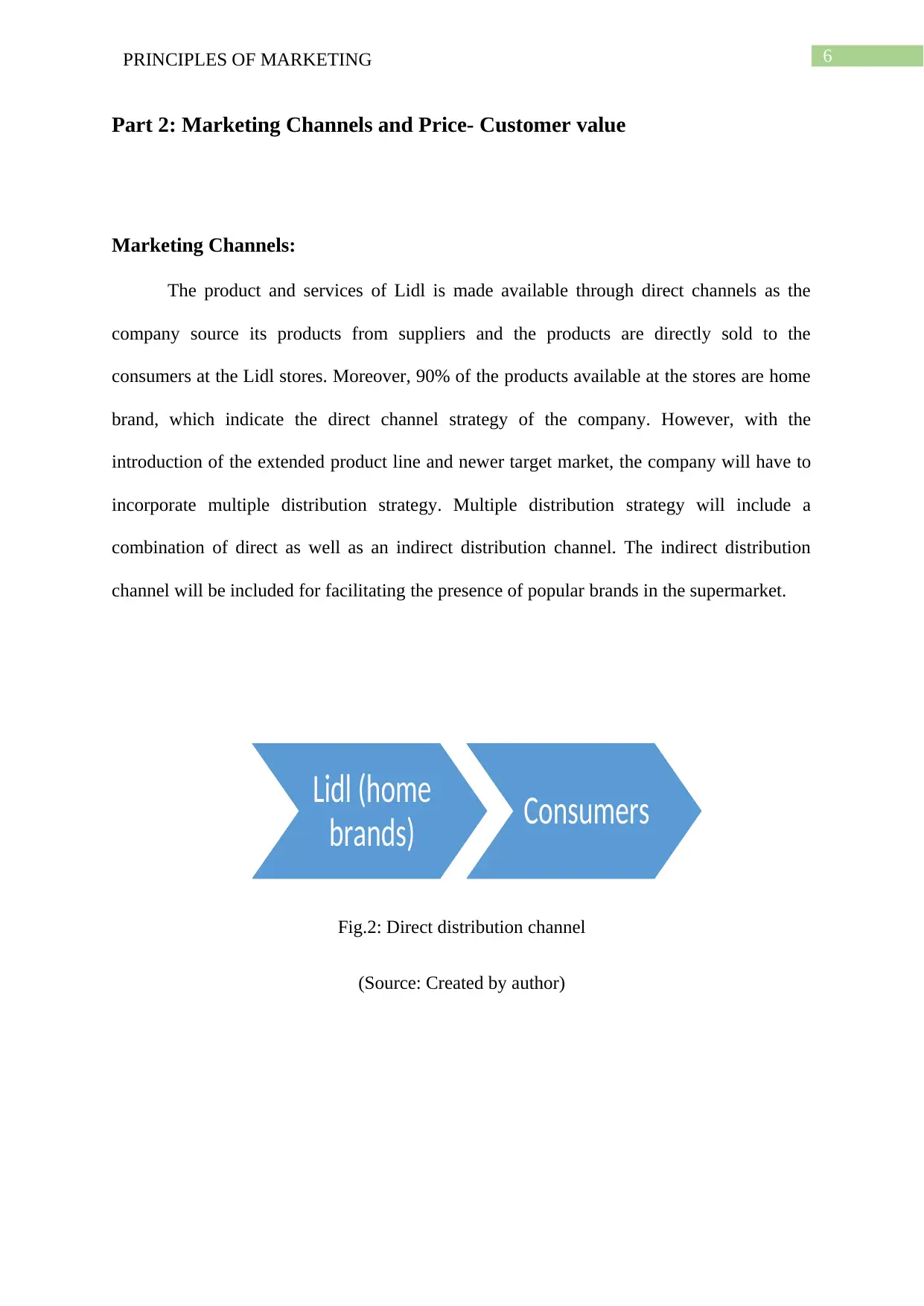
6PRINCIPLES OF MARKETING
Part 2: Marketing Channels and Price- Customer value
Marketing Channels:
The product and services of Lidl is made available through direct channels as the
company source its products from suppliers and the products are directly sold to the
consumers at the Lidl stores. Moreover, 90% of the products available at the stores are home
brand, which indicate the direct channel strategy of the company. However, with the
introduction of the extended product line and newer target market, the company will have to
incorporate multiple distribution strategy. Multiple distribution strategy will include a
combination of direct as well as an indirect distribution channel. The indirect distribution
channel will be included for facilitating the presence of popular brands in the supermarket.
Fig.2: Direct distribution channel
(Source: Created by author)
Lidl (home
brands) Consumers
Part 2: Marketing Channels and Price- Customer value
Marketing Channels:
The product and services of Lidl is made available through direct channels as the
company source its products from suppliers and the products are directly sold to the
consumers at the Lidl stores. Moreover, 90% of the products available at the stores are home
brand, which indicate the direct channel strategy of the company. However, with the
introduction of the extended product line and newer target market, the company will have to
incorporate multiple distribution strategy. Multiple distribution strategy will include a
combination of direct as well as an indirect distribution channel. The indirect distribution
channel will be included for facilitating the presence of popular brands in the supermarket.
Fig.2: Direct distribution channel
(Source: Created by author)
Lidl (home
brands) Consumers
Paraphrase This Document
Need a fresh take? Get an instant paraphrase of this document with our AI Paraphraser
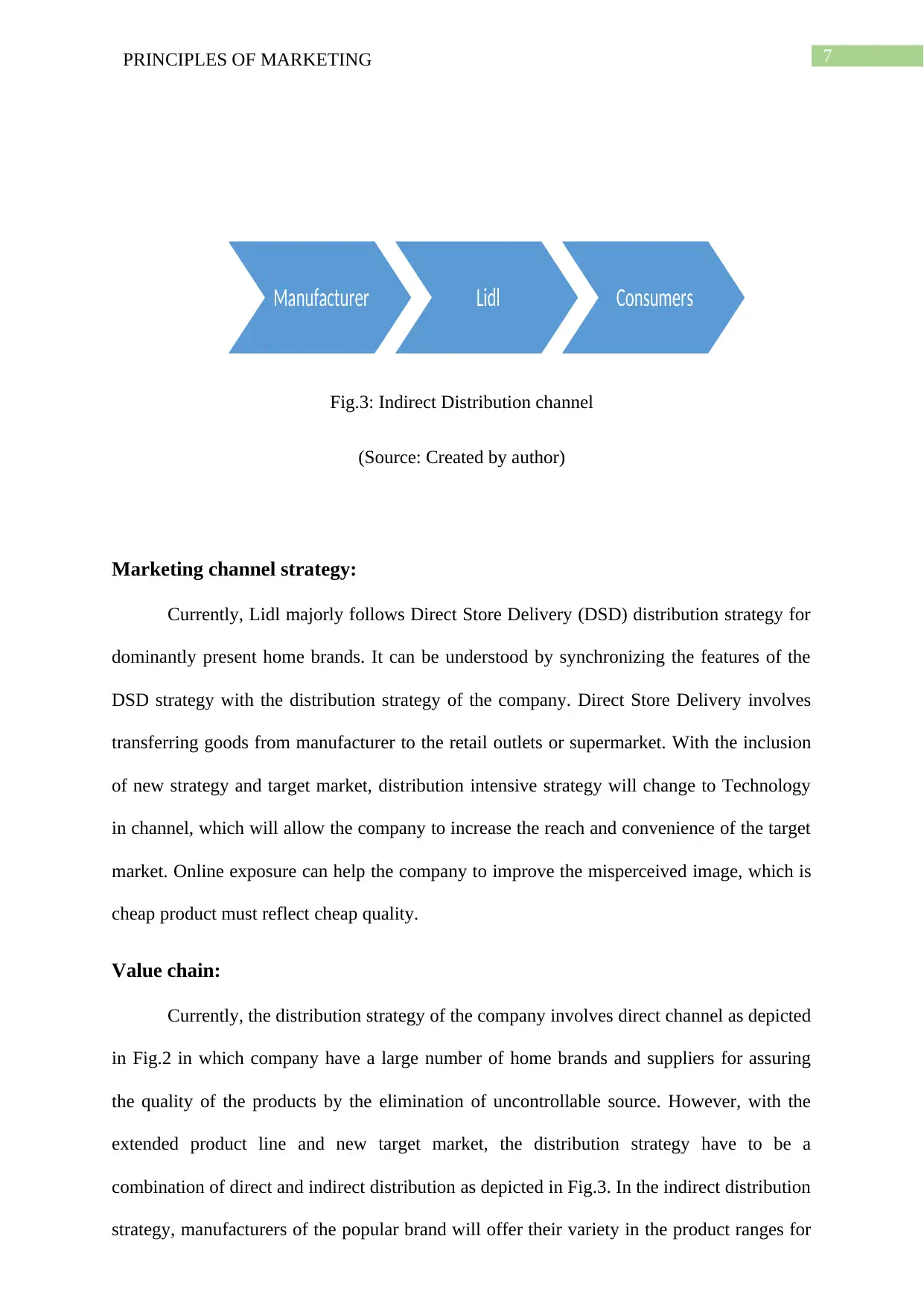
7PRINCIPLES OF MARKETING
Fig.3: Indirect Distribution channel
(Source: Created by author)
Marketing channel strategy:
Currently, Lidl majorly follows Direct Store Delivery (DSD) distribution strategy for
dominantly present home brands. It can be understood by synchronizing the features of the
DSD strategy with the distribution strategy of the company. Direct Store Delivery involves
transferring goods from manufacturer to the retail outlets or supermarket. With the inclusion
of new strategy and target market, distribution intensive strategy will change to Technology
in channel, which will allow the company to increase the reach and convenience of the target
market. Online exposure can help the company to improve the misperceived image, which is
cheap product must reflect cheap quality.
Value chain:
Currently, the distribution strategy of the company involves direct channel as depicted
in Fig.2 in which company have a large number of home brands and suppliers for assuring
the quality of the products by the elimination of uncontrollable source. However, with the
extended product line and new target market, the distribution strategy have to be a
combination of direct and indirect distribution as depicted in Fig.3. In the indirect distribution
strategy, manufacturers of the popular brand will offer their variety in the product ranges for
Manufacturer Lidl Consumers
Fig.3: Indirect Distribution channel
(Source: Created by author)
Marketing channel strategy:
Currently, Lidl majorly follows Direct Store Delivery (DSD) distribution strategy for
dominantly present home brands. It can be understood by synchronizing the features of the
DSD strategy with the distribution strategy of the company. Direct Store Delivery involves
transferring goods from manufacturer to the retail outlets or supermarket. With the inclusion
of new strategy and target market, distribution intensive strategy will change to Technology
in channel, which will allow the company to increase the reach and convenience of the target
market. Online exposure can help the company to improve the misperceived image, which is
cheap product must reflect cheap quality.
Value chain:
Currently, the distribution strategy of the company involves direct channel as depicted
in Fig.2 in which company have a large number of home brands and suppliers for assuring
the quality of the products by the elimination of uncontrollable source. However, with the
extended product line and new target market, the distribution strategy have to be a
combination of direct and indirect distribution as depicted in Fig.3. In the indirect distribution
strategy, manufacturers of the popular brand will offer their variety in the product ranges for
Manufacturer Lidl Consumers
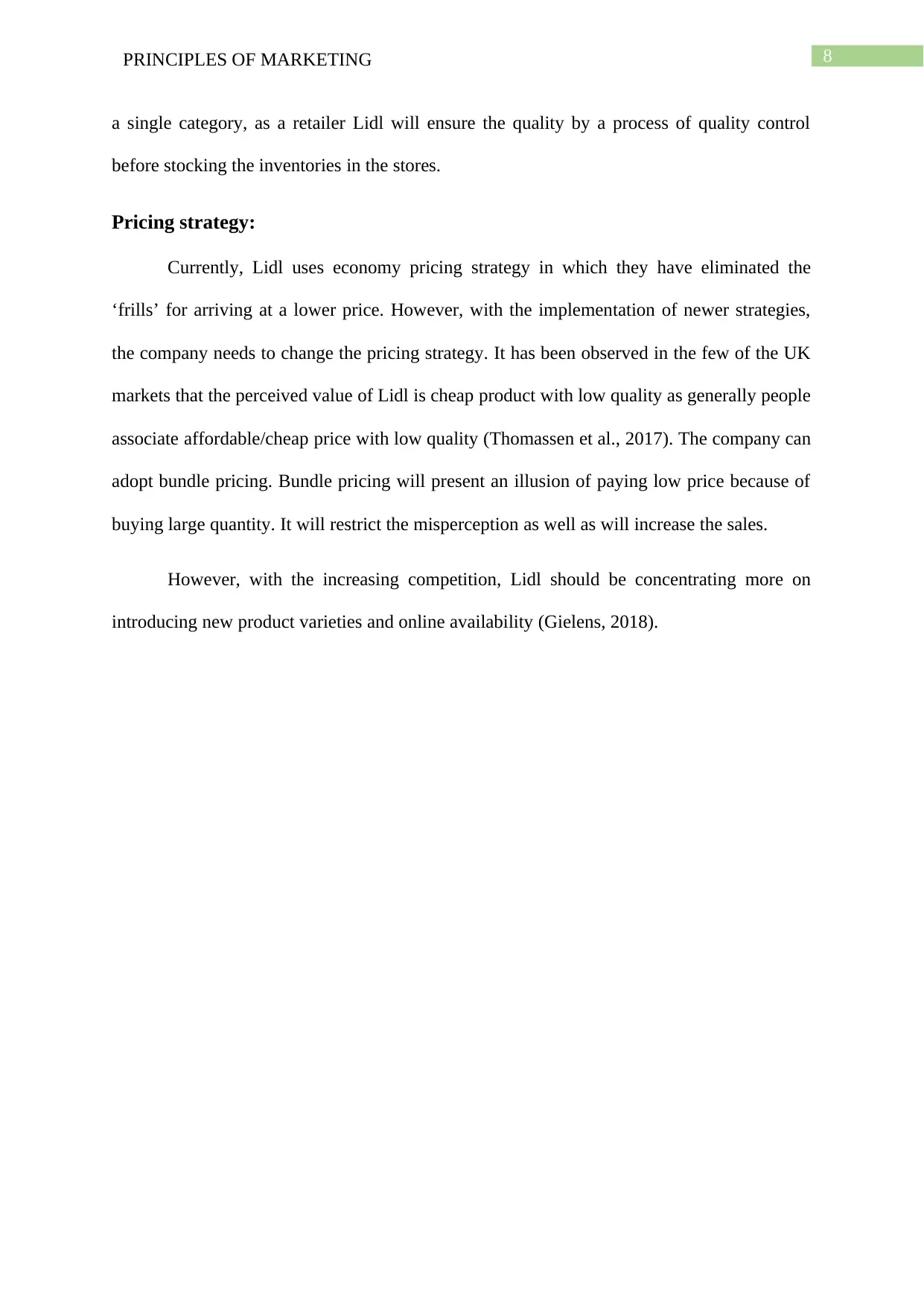
8PRINCIPLES OF MARKETING
a single category, as a retailer Lidl will ensure the quality by a process of quality control
before stocking the inventories in the stores.
Pricing strategy:
Currently, Lidl uses economy pricing strategy in which they have eliminated the
‘frills’ for arriving at a lower price. However, with the implementation of newer strategies,
the company needs to change the pricing strategy. It has been observed in the few of the UK
markets that the perceived value of Lidl is cheap product with low quality as generally people
associate affordable/cheap price with low quality (Thomassen et al., 2017). The company can
adopt bundle pricing. Bundle pricing will present an illusion of paying low price because of
buying large quantity. It will restrict the misperception as well as will increase the sales.
However, with the increasing competition, Lidl should be concentrating more on
introducing new product varieties and online availability (Gielens, 2018).
a single category, as a retailer Lidl will ensure the quality by a process of quality control
before stocking the inventories in the stores.
Pricing strategy:
Currently, Lidl uses economy pricing strategy in which they have eliminated the
‘frills’ for arriving at a lower price. However, with the implementation of newer strategies,
the company needs to change the pricing strategy. It has been observed in the few of the UK
markets that the perceived value of Lidl is cheap product with low quality as generally people
associate affordable/cheap price with low quality (Thomassen et al., 2017). The company can
adopt bundle pricing. Bundle pricing will present an illusion of paying low price because of
buying large quantity. It will restrict the misperception as well as will increase the sales.
However, with the increasing competition, Lidl should be concentrating more on
introducing new product varieties and online availability (Gielens, 2018).
⊘ This is a preview!⊘
Do you want full access?
Subscribe today to unlock all pages.

Trusted by 1+ million students worldwide
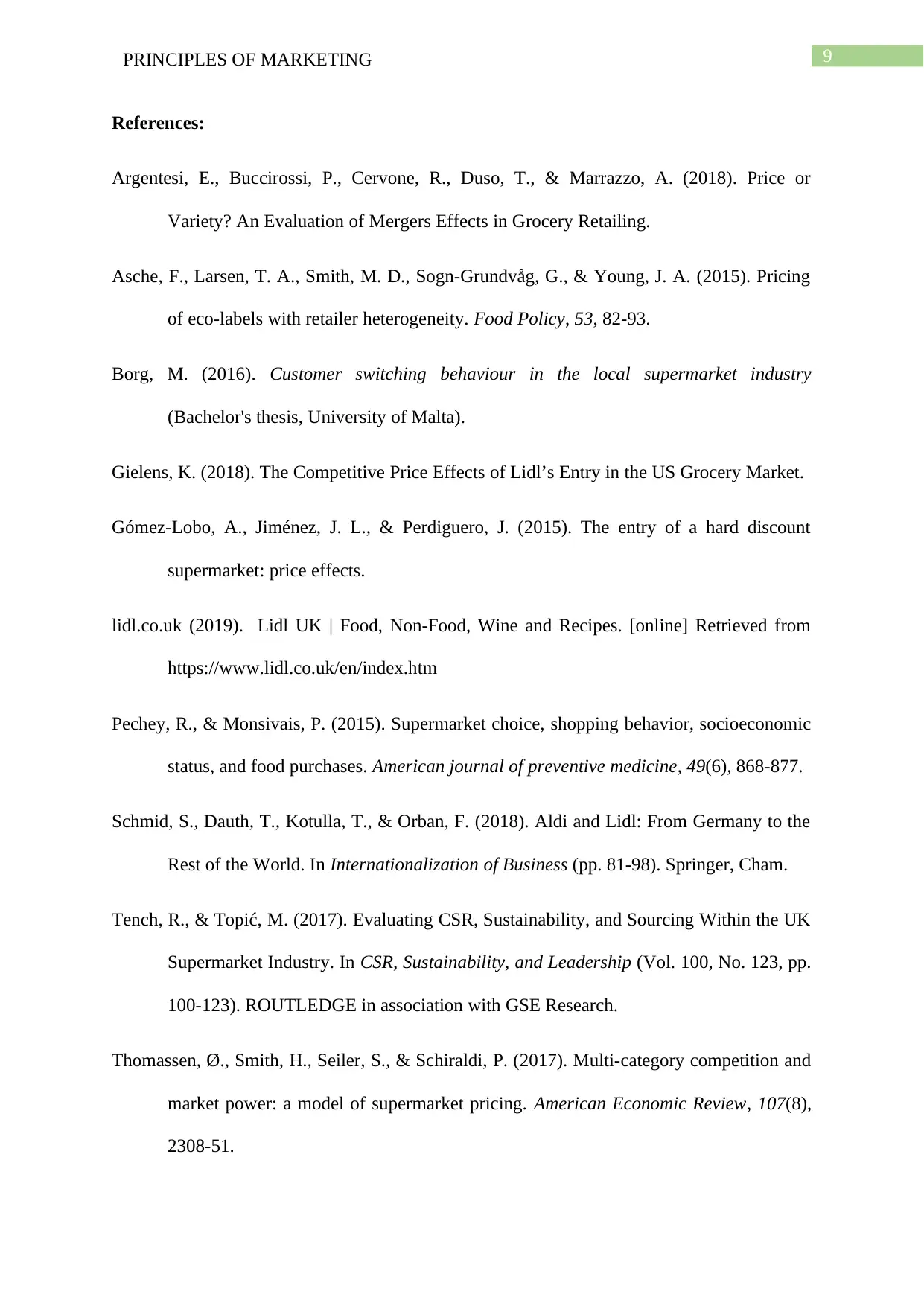
9PRINCIPLES OF MARKETING
References:
Argentesi, E., Buccirossi, P., Cervone, R., Duso, T., & Marrazzo, A. (2018). Price or
Variety? An Evaluation of Mergers Effects in Grocery Retailing.
Asche, F., Larsen, T. A., Smith, M. D., Sogn-Grundvåg, G., & Young, J. A. (2015). Pricing
of eco-labels with retailer heterogeneity. Food Policy, 53, 82-93.
Borg, M. (2016). Customer switching behaviour in the local supermarket industry
(Bachelor's thesis, University of Malta).
Gielens, K. (2018). The Competitive Price Effects of Lidl’s Entry in the US Grocery Market.
Gómez-Lobo, A., Jiménez, J. L., & Perdiguero, J. (2015). The entry of a hard discount
supermarket: price effects.
lidl.co.uk (2019). Lidl UK | Food, Non-Food, Wine and Recipes. [online] Retrieved from
https://www.lidl.co.uk/en/index.htm
Pechey, R., & Monsivais, P. (2015). Supermarket choice, shopping behavior, socioeconomic
status, and food purchases. American journal of preventive medicine, 49(6), 868-877.
Schmid, S., Dauth, T., Kotulla, T., & Orban, F. (2018). Aldi and Lidl: From Germany to the
Rest of the World. In Internationalization of Business (pp. 81-98). Springer, Cham.
Tench, R., & Topić, M. (2017). Evaluating CSR, Sustainability, and Sourcing Within the UK
Supermarket Industry. In CSR, Sustainability, and Leadership (Vol. 100, No. 123, pp.
100-123). ROUTLEDGE in association with GSE Research.
Thomassen, Ø., Smith, H., Seiler, S., & Schiraldi, P. (2017). Multi-category competition and
market power: a model of supermarket pricing. American Economic Review, 107(8),
2308-51.
References:
Argentesi, E., Buccirossi, P., Cervone, R., Duso, T., & Marrazzo, A. (2018). Price or
Variety? An Evaluation of Mergers Effects in Grocery Retailing.
Asche, F., Larsen, T. A., Smith, M. D., Sogn-Grundvåg, G., & Young, J. A. (2015). Pricing
of eco-labels with retailer heterogeneity. Food Policy, 53, 82-93.
Borg, M. (2016). Customer switching behaviour in the local supermarket industry
(Bachelor's thesis, University of Malta).
Gielens, K. (2018). The Competitive Price Effects of Lidl’s Entry in the US Grocery Market.
Gómez-Lobo, A., Jiménez, J. L., & Perdiguero, J. (2015). The entry of a hard discount
supermarket: price effects.
lidl.co.uk (2019). Lidl UK | Food, Non-Food, Wine and Recipes. [online] Retrieved from
https://www.lidl.co.uk/en/index.htm
Pechey, R., & Monsivais, P. (2015). Supermarket choice, shopping behavior, socioeconomic
status, and food purchases. American journal of preventive medicine, 49(6), 868-877.
Schmid, S., Dauth, T., Kotulla, T., & Orban, F. (2018). Aldi and Lidl: From Germany to the
Rest of the World. In Internationalization of Business (pp. 81-98). Springer, Cham.
Tench, R., & Topić, M. (2017). Evaluating CSR, Sustainability, and Sourcing Within the UK
Supermarket Industry. In CSR, Sustainability, and Leadership (Vol. 100, No. 123, pp.
100-123). ROUTLEDGE in association with GSE Research.
Thomassen, Ø., Smith, H., Seiler, S., & Schiraldi, P. (2017). Multi-category competition and
market power: a model of supermarket pricing. American Economic Review, 107(8),
2308-51.
1 out of 10
Related Documents
Your All-in-One AI-Powered Toolkit for Academic Success.
+13062052269
info@desklib.com
Available 24*7 on WhatsApp / Email
![[object Object]](/_next/static/media/star-bottom.7253800d.svg)
Unlock your academic potential
Copyright © 2020–2025 A2Z Services. All Rights Reserved. Developed and managed by ZUCOL.





